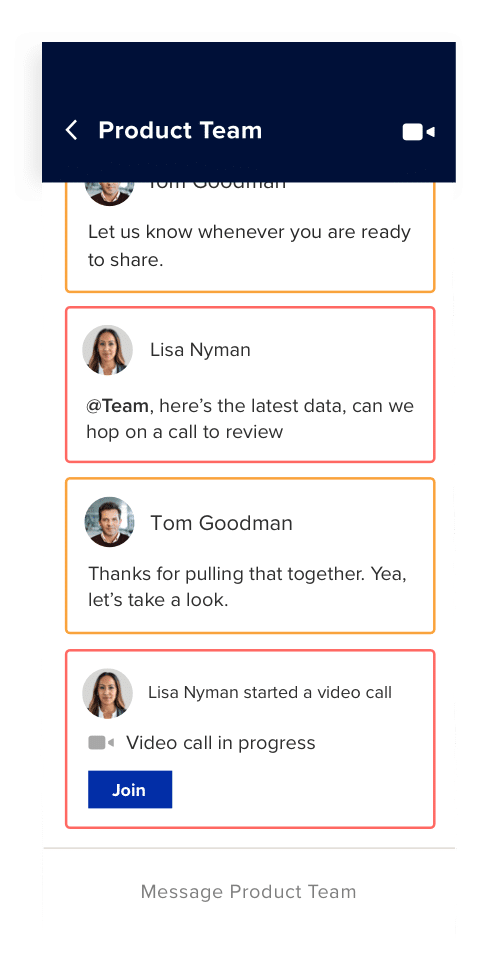When you only have one or two representatives on your sales team, it’s pretty easy to figure out who’s handling what. But once your team starts growing, you’ll need a proper system to make sure there are no gaps and overlaps in work.
Many companies use territories to organize their sales team’s activities. These are regions, industries, or account types assigned to a specific salesperson or sales team. Once a rep is assigned to a particular territory, they’d be responsible for managing and connecting with all of the accounts, leads, and prospects within it, as well as meeting their overall revenue and sales goals.
Making a sales territory plan isn’t a simple task, so these days, most sales teams turn to sales territory management software to get the job done. But before you drop money on a new platform, you should know what to do with it and understand which tools make the most sense for your business.
In this post, we’ll look into:
- What is sales territory mapping software?
- What defines a sales territory?
- What is territory mapping?
- How do you make a territory map?
- Why do you need it?
- The 5 best sales territory mapping software platforms
Up your sales productivity game and close more deals with these free cold outreach scripts. ☎️
What is sales territory mapping software?
While you can map and assign sales territories using Excel spreadsheets or physical maps, this’ll take forever. And who’s got time for that?
This is where sales territory mapping software comes in. These are types of sales software that you can use to automatically assign leads or accounts to specific salespeople according to the territory they manage.
What defines a sales territory?
A sales territory organizes customers, leads, and prospects into groups according to certain criteria, such as location, industry, or account type. For example, a sales territory may cover all of the west coast of the US. Or it may cover the real estate industry.
Generally, a territory should be manageable by an individual salesperson or sales team. It should also contain enough prospects, leads, and customers for them to hit their sales targets but not too many that they get overwhelmed.
What is territory mapping?
As we mentioned earlier, you can define a sales territory in several different ways. Just make sure you choose your criteria based on your business and your unique priorities and goals.
For example, if your sales team travels a lot, using a local location-based approach will help ensure they can actually reach all of the customers they need to visit. However, if your sales team is remote and handles a lot of online leads, an industry or size-based approach might make more sense.
Once you define your territories, you can map them out so your team can see exactly where they need to go and who they need to speak to.
How do you make a territory map?
Step 1: Create your customer segments.
First things first, you need to define your customer segments, and you can do this in four ways:
Location
With a location-based customer segment, a sales rep or team would manage all of the accounts within a certain geographic area, regardless of the size or type of account. This is one of the most straightforward ways to create a territory but could also lead to an uneven concentration of accounts if one territory has more accounts than another.
Size
Size-based segments would group together similarly sized businesses, usually determined by the client’s annual revenue or their annual spend with your business. For example, large clients spending $20,000 or more on your business could be segmented together. This type of segmentation can be tricky to implement, but it gives your sales team the chance to really understand the unique challenges, needs, and budgets of different sized businesses and tailor their approach accordingly.
Industry
Segmenting by industry involves organizing your business’s customers according to the industry in which they operate, like education, government, healthcare, or retail. Like size-based segments, this approach can also be tricky to implement, but it allows your team to become subject matter experts and gain a lot of experience working with a particular industry.
Alternatively, if you know that your sales reps are already familiar with a certain industry, you can help them play to their strengths by assigning them to territories based on their past experience.
Hybrid approach
Last but not least, you can use a hybrid segmentation approach where you might have different sales reps handle different-sized businesses or industries within the same geographic area.
This approach can be harder to set up, as you’ll have to spend some time defining and creating multiple layers of customer segments, but it’s useful for larger teams that handle a lot of leads and accounts and need a systematic way to divide up the work.
Step 2: Define your territories.
Once you’ve segmented your customers, you need to group them into territories. You want to set your sales team up for success, so make sure you consider the following before you finalize your territories:
- Account distribution: How many current accounts are located in each territory? Is it a manageable number? Is there an even distribution, or do some territories have a lot more accounts than others?
- Prospect availability: Are there enough potential prospects in the territory for your sales reps to hit their goals? According to experts, a viable territory should have a minimum 2:1 ratio of potential prospects to existing customers.
- Overall business presence: How will your team interact with prospects and serve the needs of your customers? How will they generate new prospects and leads? Handle sales consultations?
Once you know for sure that each territory has a manageable number of potential prospects, leads, and customers, you can move on to the final step of the mapping process.
Step 3: Make your assignments.
Once you’ve defined your territories, you need to figure out which sales reps will be covering them. There are two key ways you can do this: assign reps to territories based on their expertise or their location.
If you were to make assignments based on expertise, you’d try to match your sales reps to territories based on their skill level or previous experience. For example, if you have a new rep on your team with a background in tech, you might want to give them a smaller territory with a high concentration of tech businesses.
Alternatively, if you were to make assignments based on location, you would simply assign territories to team members based on their location in that territory. This is a useful approach if you have a field sales team that needs to travel to different businesses and engage with prospects and customers in person.
But if you have a remote sales team or get a lot of leads through online channels, your reps’ physical locations don’t matter as much.
Of course, you could also use a combination of the two approaches to make sure your team’s abilities align with the customers they’re serving while also making sure that they can efficiently meet with everybody they need to.
[ebook-download title=”Learn more about managing your finances as a remote team” src=”” link=”https://www.ringcentral.com/remote-work-finance-playbook.html”]
Why do you need sales territory planning software?
There’s a lot that goes into building a territory map, and if your team or business is rapidly growing, assigning new leads and customers to your sales team can quickly become a full-time job in and of itself. Here are some of the benefits of using a sales territory planning software instead.
Automate repetitive tasks
Sales mapping software automates a lot of the repetitive tasks involved in the process, saving you a ton of time and effort. You can create new territories, name them, and then create rules that’ll automatically assign new prospects to their appropriate territories and assign reps to incoming leads and contacts.
You can also set up rules to move leads and deals from one territory to another as your team grows and create revenue and sales goals for each territory.
Motivate your team
Sales territory mapping apps can also help your team stay motivated and accountable as they can see exactly who they need to reach and what targets they need to hit whenever they open the app.
Establish clear boundaries
Last but definitely not least, mapping software for sales territories helps sales teams establish clear boundaries, so everybody knows exactly what leads and customers they’re responsible for and so there are no overlaps.
The 5 best sales territory mapping software platforms
Ready to build a top-notch sales territory map? The following sales mapping tools will get you up and running in no time.
1. Badger Maps
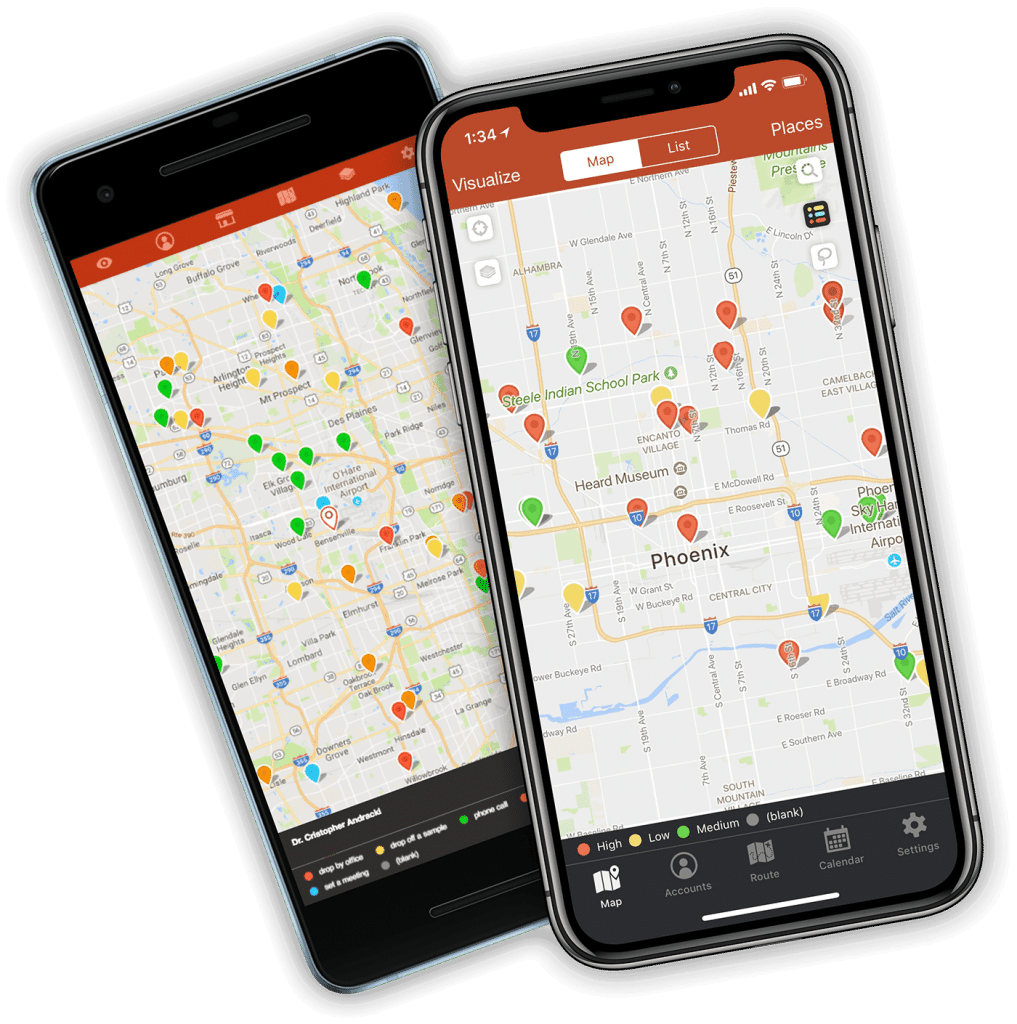
Badger Maps is a territory mapping software that’s perfect for sales teams on the go. You can upload your customer lists to the app, and it turns the data into an interactive map of your sales territory, with color-coded pins to show you exactly where your customers are located.
Strengths
Route optimization is the name of Badger Maps’ game. This app will automatically determine the fastest route between multiple destinations, saving your reps time and gas money. You can also record customer check-ins in the app, so you can keep track of interactions while you’re on the go. It also has a neat lasso function that allows you to select a group of locations and mass update them.
Drawbacks
Some users have reported that it can be tricky to get started with Badger Maps, as its robust list of features can get pretty overwhelming. Others wish the app had a mileage tracker so they can use it for tax deductions.
Pricing options
Badger Maps pricing starts at $49 per user per month. Its Enterprise plan starts at $95 per user per month and includes additional features like priority phone support, one-on-one training, custom CRM integrations, and more.
2. Salesforce Maps
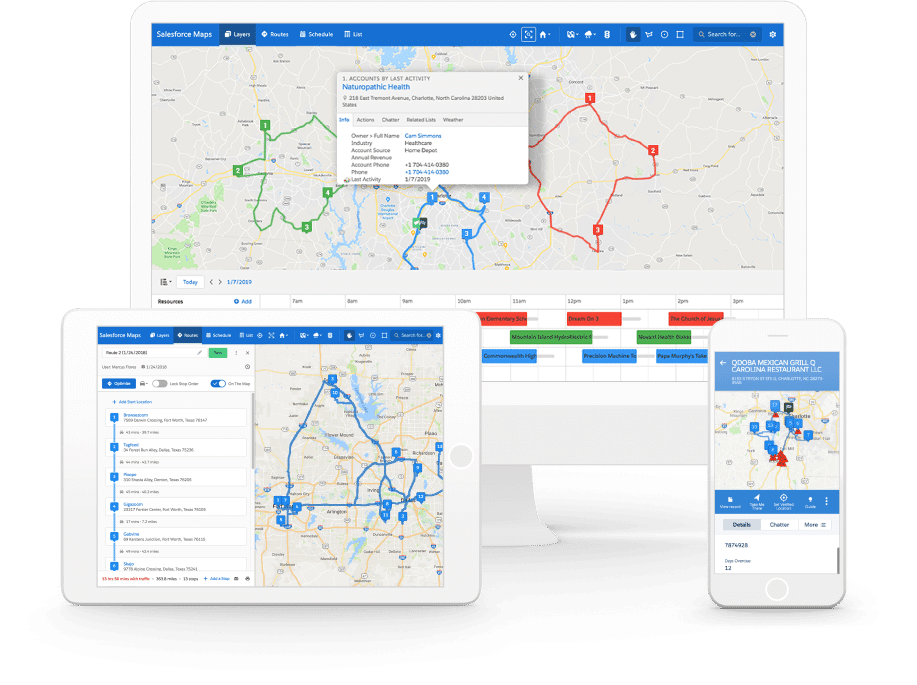
Formerly MapAnything, Salesforce Maps allows you to build and manage sales territories, optimize routes, and create optimized schedules that help your sales reps maximize their time with their most valuable customers and prospects.
Strengths
This app can do almost anything your sales team needs to do when it comes to sales territory management. It can optimize travel routes, show contacts within a radius or outside of a radius, and even layer multiple sets of contacts onto a single map. You can also export lists and view the map in miles or kilometres, which is useful for international and remote teams.
Drawbacks
Similar to Badger Maps, Salesforce Maps isn’t the easiest sales app to use at first. Additionally, since it’s powered by Google Maps, it works best with US addresses. Some users have found that its results aren’t as accurate with international locations.
Pricing options
Pricing information is not available for Salesforce Maps, but potential users can request a demo.
3. eSpatial
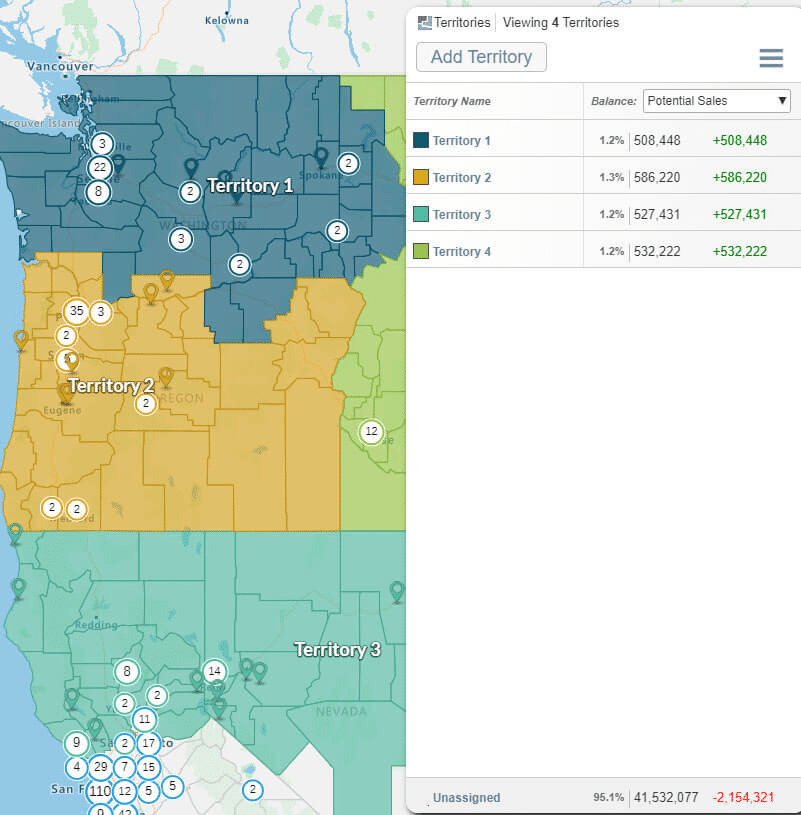
eSpatial is a territory management solution that can create new territories in minutes. You can also use the tool to balance and reorganize territories to evenly distribute accounts among your sales team. From there, sales reps can use the tool to map out and optimize their routes, create performance reports, and more.
Strengths
Users report that the app is very simple to use, while still offering extremely data-rich mapping capabilities. eSpatial also has a responsive customer service team that addresses issues and concerns promptly and patiently.
Drawbacks
When it comes to its graphics, eSpatial isn’t quite as visually appealing as other options on this list. Some users have also pointed out that its database library is a little difficult to navigate, which can make it tricky for them to see all of their maps at a glance.
Pricing options
eSpatial’s Pro plan costs a flat rate of $1,295 per year. This includes one user licence and features like data visualization, drive time analysis, route optimization, and more. Its Team plan costs $2,995 per year and includes all the Pro plan features, plus five user licenses, Salesforce integration, and other features. eSpatial also has a more feature-packed Team Plus plan ($5,995 per year) and Enterprise plans (custom rate).
4. Spotio
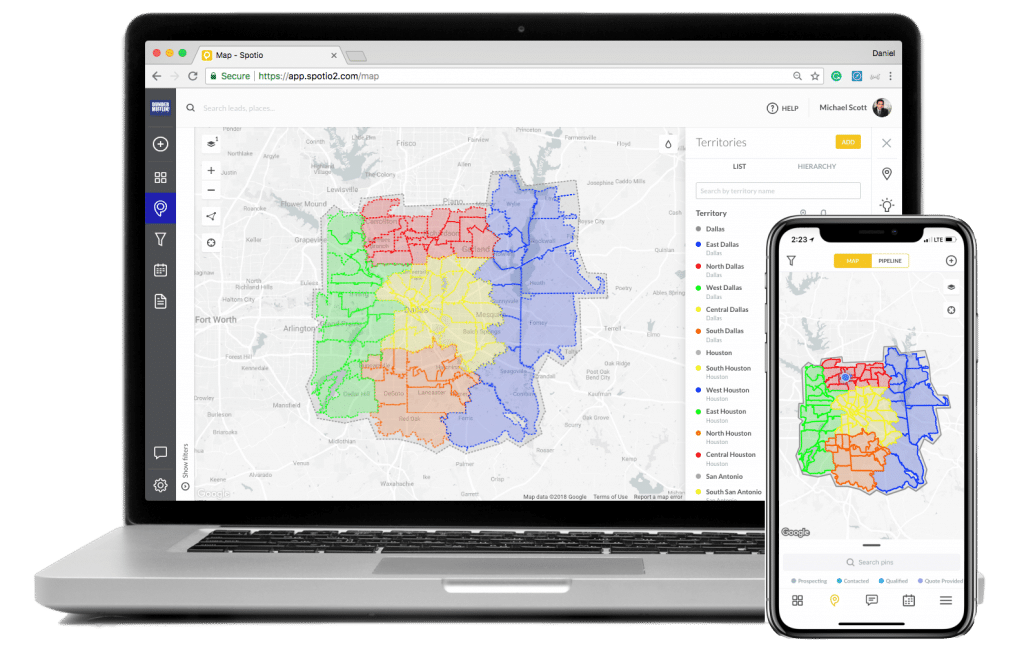
Spotio is an end-to-end field sales solution that supports teams with prospecting, customer enablement, and sales optimization. In terms of territory management, you can use Spotio to define your territories by ZIP code, build territory action plans, set goals, and take notes on the go.
Strengths
Spotio’s biggest asset is its built-in tracking system, which allows you to closely track your team to keep them accountable. Users also report that its interface is very easy to use and navigate.
Drawbacks
When you zoom out in Spotio, the map becomes less detailed, which can be frustrating if you want to see everything at once from a macro level.
Pricing options
Spotio starts at $39 per user per month for its Team plan, which includes five users. Its Business plan is $69 per user per month for 10 users, and its Enterprise plan is $129 per user per month for 100 users.
5. Maptive
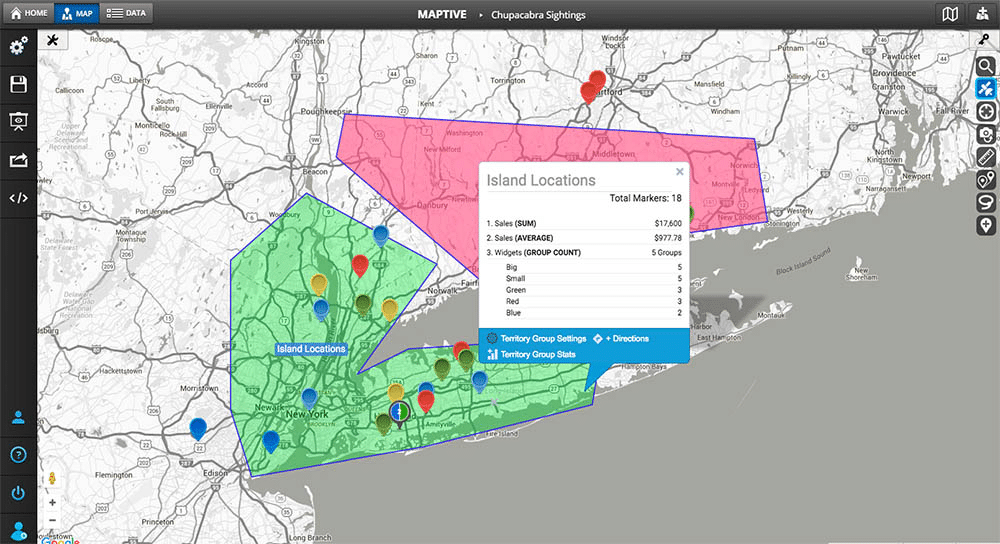
With Maptive, you can create maps for sales territories in seconds. All you need to do is upload your location-based data to the platform, and Maptive will create a custom map. From there, you can customize the map by drawing your own sales territory boundaries or using predefined ones like ZIP codes. The app can also group important data, like total sales and demographic information.
Strengths
Maptive’s customization features are hard to beat. For instance, its territory tool allows you to draw custom shapes to represent different territories and then instantly tally up the number of locations or the total amount of sales within that territory to assess its viability. Territory mapping doesn’t get much easier than that.
Drawbacks
Maptive can be expensive if you have a smaller team that only needs to use sales mapping tools a couple of times a year. However, its $250 45 Day Pass pricing tier may be a good fit if you have less frequent mapping needs, but it doesn’t offer as many locations or geocodes as the yearly subscriptions.
Pricing options
Maptive pricing starts at $250 for a 45-day pass. This includes one user license, 15 recyclable maps, 30,000 locations per map, and 70,000 geocodes per month. For $1,250 per year, you get one user licence, 40 recyclable maps, 100,000 locations per month and 500,000 geocodes per month. Lastly, for $2,500 per year, you get five user licenses, 100 recyclable maps, 100,000 locations per map, and 1,000,000 geocodes per month.
Bonus: Use a communications platform to help your sales team collaborate
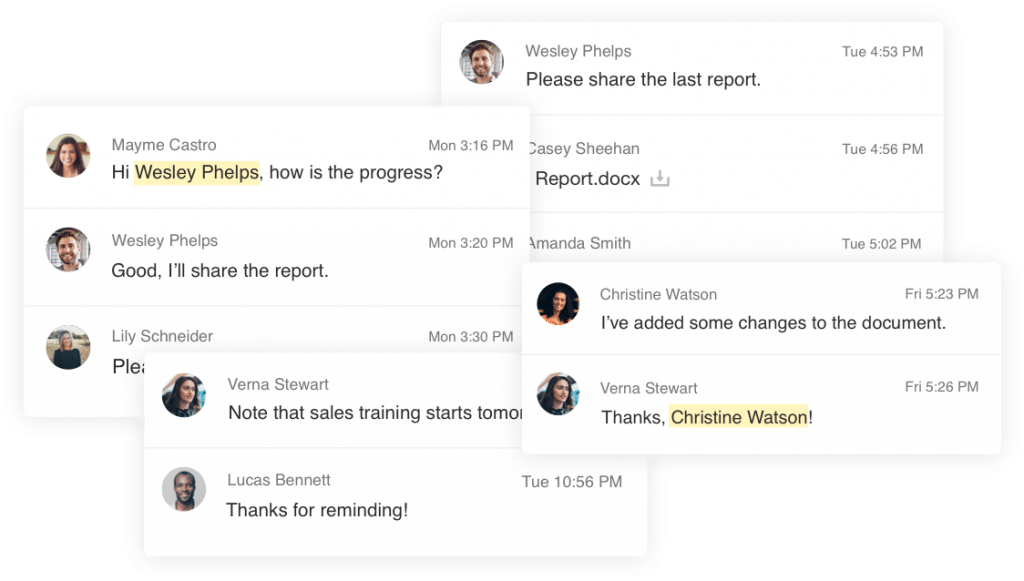
Once you’ve mapped out your territories and doled out your assignments, you can help your team work smarter, not harder, by adding a team collaboration tool into the mix.
Even though your sales reps might be handling territories on their own, they still need the support of their team to get feedback and advice. Plus, since they’re probably not always at their desk, a digital collaboration hub can help your sales team stay connected, wherever they happen to be:
With RingCentral’s team messaging tool, your sales team can connect in real time via chat and video calls, share files, and track tasks. They can even use its built-in chat and video conferencing software to connect with clients and prospects virtually.
And since RingCentral integrates with over 50 apps—including Salesforce and Google Drive—your team can pull updates from these apps right into their in-app conversations.
Make the most of sales territory mapping
Thanks to the wide variety of sales territory mapping software available on the market, there’s never been a better time to bring this valuable sales tactic into your organization.
Say goodbye to sales overlaps, uneven customer distribution, and mismatched targets, and hello to increased efficiency and productivity.
With the right sales territory mapping tool in place, you can set your sales reps up for success from the get-go.
Originally published Feb 01, 2020, updated Jun 18, 2024


